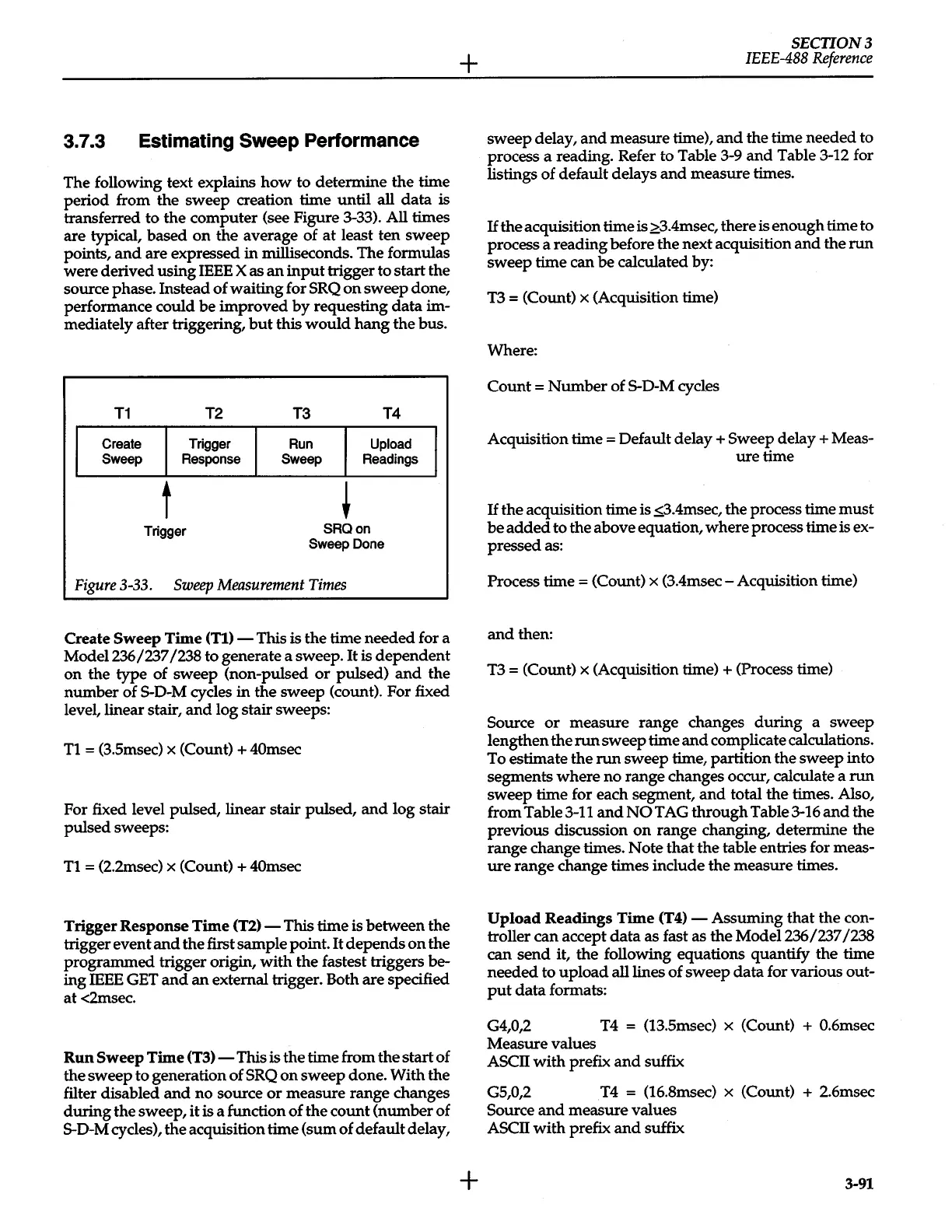3.7.3
Estimating
Sweep
Performance
The
following text explains
how
to
determine
the
time
period
from
the
sweep
creation time
until
all
data
is
transferred
to
the
computer
(see Figure 3-33). All times
are
typical,
based
on
the
average
of
at
least
ten
sweep
points,
and
are
expressed
in
milliseconds.
The
formulas
were
derived
using
IEEE
X
as
an
input
trigger
to
start
the
source phase. Instead
of
waiting
for SRQ
on
sweep
done,
performance could
be
improved
by
requesting
data
im-
mediately after triggering,
but
this
would
hang
the
bus.
T1
T2 T3
T4
Create Trigger
Run
Upload
Sweep Response
Sweep
Readings
t
+
SRQon
Trigger
Sweep
Done
Figure
3-33.
Sweep
Measurement
Times
Create
Sweep
Time
(Tl)
-This
is
the
time
needed
for a
Model236
/237/238
to
generate a sweep.
It
is
dependent
on
the
type
of
sweep
(non-pulsed
or
pulsed)
and
the
number
of
S-0-M
cycles
in
the
sweep
(count). For fixed
level, linear stair,
and
log stair sweeps:
T1
=
(3.5msec)
x
(Count)
+
40msec
For fixed level pulsed, linear stair pulsed,
and
log stair
pulsed
sweeps:
T1
=
(2.2msec)
x
(Count)
+
40msec
Trigger
Response
Time
(T2)-
This time is
between
the
trigger
event
and
the first
sample
point.
It
depends
on
the
programmed
trigger origin,
with
the
fastest triggers be-
ing
IEEE GET
and
an
external trigger. Both
are
specified
at<2msec.
Run
Sweep
Time
(T3)-
This is
the
time from
the
start
of
the
sweep
to
generation
of
SRQ
on
sweep
done.
With
the
filter disabled
and
no
source
or
measure
range
changes
during
the sweep, it is a function
of
the
count
(number
of
S-D-M cycles),
the
acquisition time
(sum
of
default delay,
+
+
SECTION3
IEEE-488
Reference
sweep
delay,
and
measure
time),
and
the time
needed
to
process a reading. Refer to Table 3-9
and
Table 3-12 for
listings
of
default delays
and
measure
times.
If
the
acquisition time is
~3.4msec,
there is
enough
time to
process a
reading
before
the
next acquisition
and
the
run
sweep
time can
be
calculated by:
T3 = (Count)
x (Acquisition time)
Where:
Count=
Number
of
S-0-M
cycles
Acquisition time = Default delay
+
Sweep
delay
+
Meas-
ure
time
If
the
acquisition time is
.:::;3.4msec,
the process time
must
be
added
to
the
above equation,
where
process time is ex-
pressedas:
Process time = (Count)
x
(3.4msec-
Acquisition time)
and
then:
T3 = (Count)
x
(Acquisition time)
+
(Process time)
Source
or
measure
range
changes
during
a
sweep
lengthen
the
run
sweep
time
and
complicate calculations.
To estimate
the
run
sweep
time, partition
the
sweep
into
segments
where
no
range
changes occur, calculate a
run
sweep
time for each segment,
and
total
the
times. Also,
from Table3-11
and
NO
TAG
through
Table3-16and
the
previous discussion
on
range
changing, determine the
range
change times.
Note
that
the
table entries for meas-
ure
range
change times include the measure times.
Upload
Readings
Time
(T4) -
Assuming
that
the
con-
troller
can
accept
data
as
fast
as
the
Model236/237
/238
can
send
it,
the
following equations quantify
the
time
needed
to
upload
all lines
of
sweep
data
for various out-
put
data
formats:
G4,0,2
T4 = (13.5msec)
x
(Count)
+
0.6msec
Measure values
ASCII
with
prefix
and
suffix
G5,0,2
T4 = (16.8msec)
x
(Count)
+
2.6msec
Source
and
measure
values
ASCII
with
prefix
and
suffix
3-91
